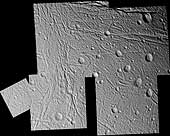|
COMETS EARTH JUPITER KUIPER BELT MARS MERCURY METEORITES NEPTUNE OORT CLOUD PLUTO SATURN SOLAR SYSTEM SPACE SUN URANUS VENUS ORDER PRINTS
PHOTO CATEGORIES SCIENCEVIEWS AMERICAN INDIAN AMPHIBIANS BIRDS BUGS FINE ART FOSSILS THE ISLANDS HISTORICAL PHOTOS MAMMALS OTHER PARKS PLANTS RELIGIOUS REPTILES SCIENCEVIEWS PRINTS
|
Related Documents
Download Options
The complex history of Enceladus' surface is revealed in great detail in this mosaic of images taken during Cassini's closest encounter with this intriguing icy moon. Fractures are nearly ubiquitous in this terrain, cutting across each other and across impact craters. Scientists can use the relationships between different features to determine the order in which they formed, thereby unraveling the moon's past. For example, almost all the craters in this mosaic have fractures running through their rims and floors, indicating that the craters formed first. This means that Enceladus has been geologically active relatively recently, especially compared to some of its neighbors in the Saturn system. There is an impressive variety of fractures visible here--from the wide east-west rifts near the upper left of the mosaic to the very fine north-south fractures in the center (which are approximately 100 to 400 meters, or 330 to 1,300 feet, across). Due to the complexity of this terrain, the task of unraveling Enceladus' history promises to be a worthy challenge for planetary scientists. The images in this mosaic were taken on March 9, 2005, in visible green light with the Cassini spacecraft narrow-angle camera at distances ranging from approximately 13,000 to 5,200 kilometers (8,000 to 3,200 miles) from Enceladus and at a Sun-Enceladus-spacecraft, or phase, angle ranging from 44 to 38 degrees. Resolution in the original images ranges from about 80 to 30 meters (260 to 100 feet) per pixel. |
